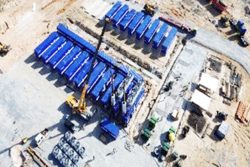More than a year ago, on June 14, 2023, the Ministry of Agriculture announced in a media release, that over 2,500 “farmers, agro processors, wholesalers and retailers now have access to certified agro-processing facilities in their regions.” Around the same time the Ministry announced that farmers and agro-processors were to benefit from “lucrative markets,” presumably, both at home and abroad. Further, in January of this year the Ministry announced, through the Department of Public Information, that in the same year, 2023, it had exported “over $1.8B in non-traditional commodities” attributing the disclosure directly to Agriculture Minister, Zulfikar Mustapha.
Going back even further, the Ministry of Agriculture had made a series of disclosures regarding the establishment of agro processing plants in various parts of the country, including hinterland locations. When these disclosures were taken together, with reports on strides being made in substantive food production in the wider agriculture sector, one had every reason to believe that the agriculture/agro processing sector was ‘sitting pretty,’ so to speak, and that we could anticipate further positive updates on the outcomes of the aforementioned encouraging developments, going forward.
Arising out of the disclosures regarding the establishment of agro processing facilities in parts of the coastal and hinterland regions one might have expected progress reports on how these facilities were impacting on the agro processing sector, as a whole, given the fact that the sector was now equipped with a considerable amount of upgraded technology. Up to this time, there has been no serious reporting on the impact of these facilities on the sector as a whole. When costly investment efforts go into creating infrastructure designed to enhance production in the agriculture/agro processing sector the outcomes of those investments manifestly belong in the public domain.
The matter of the agro processing plants is one of those examples of the Ministry of Agriculture running the risk of being perceived as having not a great deal to show, up to this time, for its investments in the agro processing facilities across much of the country. When this occurs the Ministry of Agriculture becomes vulnerable to accusations of employing misinformation to create a particular impression. The problem is that those ruses cannot sustain themselves for any length of time.
It was pretty much the same with the Ministry of Agriculture’s January 5th announcement that it had launched 130 new agro processed products, through the Guyana Marketing Corporation (GMC), though the Ministry appeared to take it for granted that it would not ever be requested to provide a list of these new products but to provide market-ready samples for public scrutiny. Here, the likely consumer response may well have counted for a great deal in terms of ‘marketing’ the products themselves, thereby advancing the interests of the agro processors as well as those of the sector as a whole.
The Ministry’s disclosure on the 130 new products was never attended by any follow-up that might have evoked some level of consumer curiosity. Here, it appears to have ‘missed the bus’ in properly marketing a noteworthy accomplishment in a sector for which it has a responsibility to the farmers, the consumers and the state.
The same applies with the state-funded agro processing executed by the Ministry of Agriculture, a feat which, if it benefits from diligent follow through can serve as a signal accomplishment not just for the Ministry of Agriculture but also as a noteworthy national and regional accomplishment given the prevailing regional food security challenges. Here, we can hardly blind our eyes to the fact that the Ministry’s focus on simply publicizing what it considers to be pleasing accomplishments counts for little in terms of the potential game-changing impact that agro processing can have on a region where our wider food security agenda appears to have lost its way, somewhat. That situation was not made any less difficult by Hurricane Beryl and her ‘rampage’ across parts of the Caribbean.
In the matter of the establishment of the agro processing facilities, for example, the Ministry of Agriculture has, as far as this newspaper is aware, failed up to this time, to go beyond its ‘feel good’ media disclosure on the reported completion of the facilities, not recognizing that its real focus ought to be on providing evidence that the facilities are not only properly up and running but, as well, actually making a difference in terms of enhancing the well-being of the farmers and agro processors, in the respective regions, matters on which the Ministry has declined to provide any substantial public disclosure..
Two points should be made at this juncture: the first, as to whether the Ministry of Agriculture ought to not now be required to provide ‘hard evidence’ that all of the agro processing facilities are ‘up and running’, and two, that their respective production agendas are linked to those of the farmers in their respective communities. A critical question here, too, has to do with whether, given what we know to be the food security challenges confronting the region, is whether there ought not to be more public disclosures on how the state-run agro processing facilities are functioning in terms of their output. Up to this time, the Ministry of Agriculture, in the course of its frequent sectoral bulletins, have not been providing regular updates on just how these facilities are functioning.
Here, we need to be able to make periodic judgements on whether the substantive purpose for which they were created, that is, the adding of another string to the bow of the country’s current food security capabilities, and by extension, to the well-being of local farmers in the respective regions and, finally, to the food security interests of the wider Caribbean region as a whole, are all in the process of being realized. These are some of the important issues on which we need to hear from the Ministry of Agriculture in the matter of the food processing facilities installed in the various regions in the period immediately ahead.









